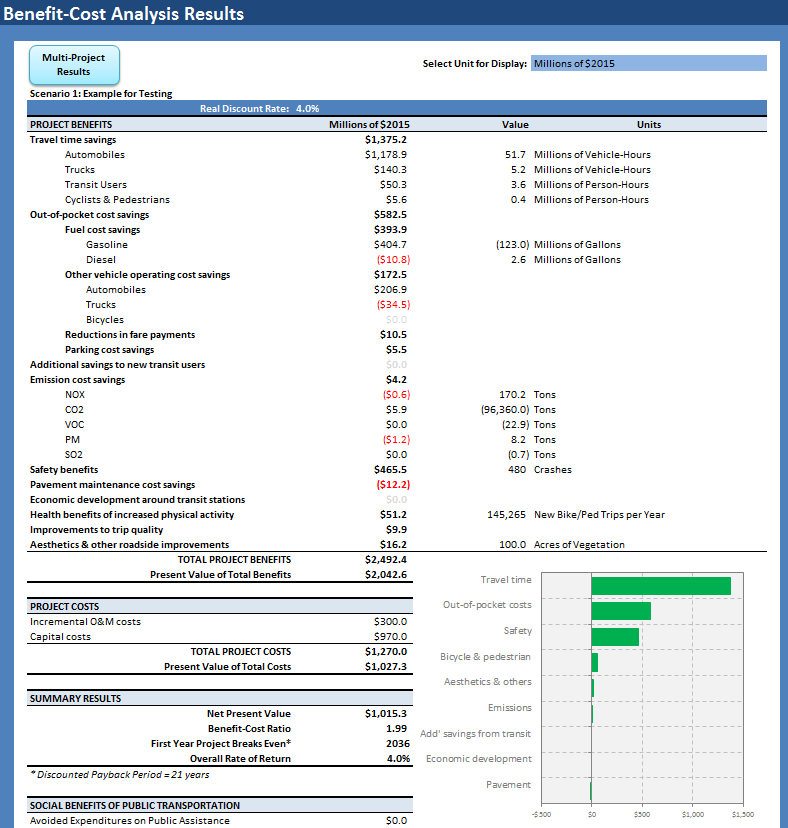FDOT’s Transportation Value to You (TransValU) Supports Benefit-Cost Analysis
Publication Year: 2017
Background
Transportation agencies are often faced with difficult decisions and need to answer questions like “which transportation project will provide the greatest return on investment?” To answer such questions, there is a need to quantify and compare the relative benefits and costs of project alternatives.
Solution
The Florida Department of Transportation (FDOT) District Five created a tool to perform economic analysis and address such questions. Transportation Value to You (TransValU) is a spreadsheet-based tool designed for corridor-level economic and financial analyses of proposed transportation investments. FDOT District Five uses the tool to assess projects focused on passenger movements, including highway, transit, bicycle/pedestrian, and combinations of these modes. The District also uses the tool to assess projects related to the movement of goods, including highway freight, rail freight, and intermodal logistics centers.
Three types of analyses are available within the tool: Benefit-Cost Analysis (BCA), Economic Impact Analysis (EIA), and Financial Analysis. For the BCA and EIA, the tool includes separate modules for the analysis of projects focused on passenger movements and projects focused on goods movements. There is only one module for financial analysis, which is the same for all project modes.
Benefit-Analysis Module
The purpose of BCA is to monetize as many of the costs and benefits of a project, program, or policy as possible. This involves quantifying the benefits and costs of an alternative relative to a base condition to determine whether the net benefits of a project outweigh the costs. TransValU provides a framework to quantify all capital, operating, and maintenance costs, as well as a wide range of benefits. TransValU provides results to help identify the alternative or mix of alternatives that maximizes net benefits or social welfare per dollar invested. The tool provides a side-by-side comparison of multiple alternatives through performance measures such as net present value, benefit-cost ratio, overall rate of return, and discounted payback period.
Figure 1 shows an example of the output from a BCA generated with TransValU. The project benefits include the travel time savings, out-of-pocket cost savings (e.g., fuel use, parking, etc.), emissions cost savings, safety benefits, pavement maintenance cost savings, economic development near transit stations, health benefits, improvements to trip quality, and aesthetic improvements. Notice the difference in project benefits among the various factors. For example, the safety benefits represent approximately 20 percent of the total project benefits. These benefits are plotted in the lower right of the figure to show the relative contribution of each factor. The project costs include the capital costs and continuing operations and maintenance (O&M) costs. Both the benefits and costs are converted to present value using the selected discount rate. The summary provides the net present value, benefit-cost ratio, overall rate of return, and discounted payback period. In this case, the discounted payback period is 21 years, and the figure notes the first year the project is projected to breakeven is 2036.

Figure 1. Sample BCA output from TransValU.
Economic Impact Analysis Module
The purpose of the EIA module is to assess the effects of a project, program, or policy on the economy of a state or region, focusing on changes in economic activity. Economic impacts are expressed as changes in business sales (output), gross regional product (GRP) or “value added,” employment, and earnings. TransValU estimates the short-term economic impacts resulting from spending on transportation projects. Long-term economic impacts are also estimated for freight projects. These are lasting impacts resulting from improvements to a transportation facility.
Financial Analysis Module
The financial analysis module focuses on the flows of money to and from a project or organization, typically a firm or government agency. It helps identify the project or alternative that maximizes net inflows (e.g., total revenue minus total expenses). A financial analysis from the perspective of a government agency looks at the impacts of a project on government expenditures and receipt.
Benefits
TransValU helps to assess the impacts of capital projects based on changes in any of the following variables:
- Changes in the number of crashes by severity resulting from projects that reduce the likelihood of crashes at a specific location and/or projects that entice travelers to use relatively safer modes.
- Changes in vehicle miles traveled (VMT) and/or vehicle hours traveled (VHT) from highway investments and/or spending in other modes affecting highway travel through modal shifts.
- Changes in the number of transit riders and/or the average transportation costs borne by transit riders, including in-vehicle travel time, waiting time, and fares.
- Changes in the number of bicycle users or pedestrians and/or changes in their average door-to door travel times.
- Changes in the percent breakdown of the transit vehicle fleet (e.g., diesel, hybrid, compressed natural gas, or electric buses and trains).
- Changes in the extent of roadside aesthetic improvements, expressed as additional acres of vegetated right-of-way.
- Changes in freight rail movements or volumes of goods handled at an integrated logistics center.
While the tool was developed by FDOT District Five, it provides the ability to perform district-level analysis for other FDOT districts. It also provides the ability to perform county level analysis, but only within District Five.
The BCA modules are consistent with the USDOT guidance for TIGER and FASTLANE grant applications. This includes methods for the valuation of impacts related to safety, travel time, and emissions. It also supports the estimation of benefits from investments in pedestrian and bicycle facilities. Using the results, agencies can make more consistent and informed decisions when developing policy or comparing and selecting project or program alternatives.
Sources
Refer to the following link for further information on the tool.
http://cfgis.org/FDOT-Resources/TransValU.aspx
Contact
Central Florida Geographic Information Systems
455 N. Garland Ave.
Suite 414
Orlando, FL 32801
Tara McCue, Director of Planning
tara@ecfrpc.org
407-245-0300
